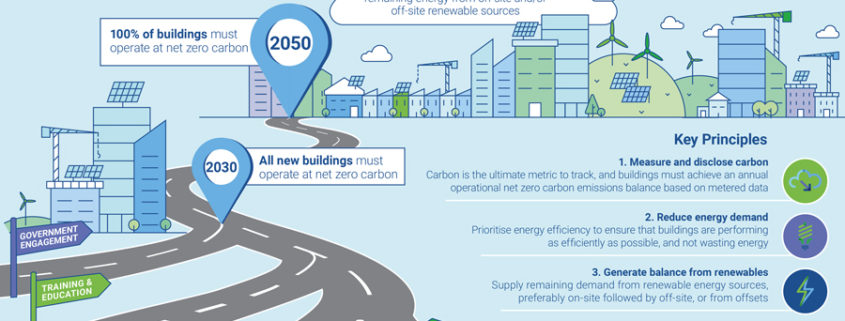Net Zero Buildings Contribute to Climate Change Solution
Over the past several months at Doo Consulting, we’ve been working on two zero-net-energy (ZNE) schools in the City of Baltimore and have been asked to submit proposals for two more ZNE projects. We have already completed two small zero-net-energy projects and have facilitated design workshops on two others. With the recent new requests, I’m sensing the beginning of a very positive trend of ultra-high performance and net zero buildings becoming increasingly attainable.
During the same period of time, the news has presented the impacts of hurricane Florence in the Carolinas, super typhoon Mangkhut in the Philippines, and the summer wildfires raging throughout the West. As I write this blog, hurricane Michael is bearing down on the Gulf Coast. Earlier this week, the International Panel on Climate Change (IPCC) issued a stern warning on the consequences of allowing global warming to exceed 1.5° Celsius. According to this recently published report, temperatures have already risen 1° C. Specific measures need to be taken by 2030, 12 years from now, to provide the best chance to avoid exceeding the 1.5° target.
How are these things related? Scientists maintain that the extreme weather we are experiencing is the result of human-caused climate change. A recent New York Times Magazine (issued August 5, 2018) recounts the efforts of scientists and politicians to raise the alarm about the dangers of climate change beginning in the early 1970’s. As it turns out, much of what scientists predicted forty years ago is coming true just as they said it would. Consequently, I take the warnings of the IPCC seriously. If we don’t act to limit the global temperature rise to 1.5°, the world that we leave our children and grandchildren will be considerably less hospitable than the present.
Admittedly, it’s difficult to wrap one’s head around, “what can I do about it?” Even if one subscribes fully to human caused climate impacts. It’s been forty years since warnings were first presented to the public and to governments around the world. In aggregate, impacts have been significant from the events previously mentioned to melting ice caps, rising sea levels, regional droughts and other subtle changes like the small temperature rise that is wreaking all of this havoc. In the US alone, the cumulative value of climate and weather related disasters since 1980 exceeds $1.5 trillion. But, to most of us, we can still get the food we need, even though farmers may experience floods or droughts. We are still comfortable in our homes even though our region may be experiencing extreme heat. We can change our vacation plans if a prediction threatens the comfort or safety of our trip. Though we may recognize that others are experiencing climate related stress, ours is limited or non-existent.
For these reasons, I’m glad that policy makers are telling us what we should do. I’m grateful for mileage standards for vehicles and emission standards for pollutants. While we may argue about the effectiveness of individual regulations, I am generally in favor science-based and purposeful regulation. Thirty years ago, governments agreed to phase-out ozone depleting substances. The ozone layer prevents harmful ultra-violet rays from reaching the surface of the planet. By 2032, the ozone layer is predicted to be restored to its 1980 levels. Success!
I’m glad that many in the professions with whom my company is involved take climate science seriously as well; architects, developers, engineers, manufacturers, government and others. How we plan our communities and design and build our buildings can contribute significantly toward mitigating climate change. The International Code Council (ICC), the American Institute of Architects (AIA), the US Green Building Council (USGBC), the American Society of Heating, Refrigerating and Air-Conditioning Engineers (ASHRAE), and others have been developing regulatory standards targeting zero net energy building requirements by 2030. The chart above shows how far energy codes have come since 1975, the period of the first oil embargo and America’s first energy crisis. During the 70’s, North American architects and builders began to explore concepts of passive design. Lessons learned were used to develop Passive House standards in Europe and have now migrated back to the US. For a while, from the mid 80’s until 2006, building codes were not demanding very much from building professionals. But, things have changed and with not a moment to spare, according to the IPCC. In 2030, the building code will require net zero energy buildings by regulation. How broadly this code will be adopted and how it will be applied across project types will be interesting to watch. My earlier mention of the zero net energy building projects is to present a hopeful trend that we hope others in the building community are sharing. We are ready for the challenge and look forward to doing our part.
The chart above shows how far energy codes have come since 1975, the period of the first oil embargo and America’s first energy crisis. During the 70’s, North American architects and builders began to explore concepts of passive design. Lessons learned were used to develop Passive House standards in Europe and have now migrated back to the US. For a while, from the mid 80’s until 2006, building codes were not demanding very much from building professionals. But, things have changed and with not a moment to spare, according to the IPCC. In 2030, the building code will require net zero energy buildings by regulation. How broadly this code will be adopted and how it will be applied across project types will be interesting to watch. My earlier mention of the zero net energy building projects is to present a hopeful trend that we hope others in the building community are sharing. We are ready for the challenge and look forward to doing our part.

